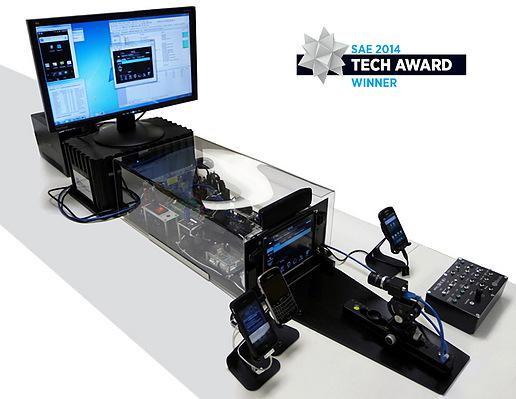DGE表示,使用HMIts可以减少67%的测试时间,并且在五个月内收回投资。
如今的市面上已经越来越多的信息娱乐系统不断被推阵出新,如何保证这些系统在发布前就能够在车辆上发挥预期的作用,是当前汽车制造商的当务之急。
“新车上装载的信息娱乐系统,其功能性和质量还存在很大的争议”,DGE公司(FEV北美公司的一个子公司)的首席执行官Joachim Wolschendorf表示,“通常这些信息娱乐系统的开发周期完全不同于动力系统以及汽车的开发周期。如果在投产之前提高其质量绝对是至关重要的。”
为迎合行业对自动测试能力的需求,DGE引入了HMIts(人机界面测试系统)。该系统通过模拟用户的语音和触摸来验证信息娱乐系统的反馈性能。这一系统使得整车厂和各级供应商能够在受控环境中对HMI(人机界面)/信息娱乐系统进行重复测试,以确保测试结果的准确性,而无需进行费时费力的人工测试。
“目前针对汽车音响,信息娱乐系统,以及各种仪表的测试基本上都是由工程师坐在一个房间里,根据测试程序人工手动一个个按下不同按钮进行的”,DGE的首席运营官Stephan Tarnutzer说,“这种测试方法基本没有可重复性和一致性可言,并且非常枯燥,不管在哪里实施操作工程师都会感到厌烦,从而容易出错,并且在重复测试时每次都会有细微的操作差异。而有了HMIts之后,测试人员能够在测试计划中设置通过和不通过测试的标准,并且能够选择不同的测试场景进行任意多次测试。测试完成之后,系统还会提交一分测试报告,因此测试人员能够确保系统经过多次测试,并且每次测试的过程都完全一致(具有可重复性),不需要人工重复测试就能够拥有大量数据用于分析问题根源。”
HMIts以图形用户界面(GUI)与标准化测试脚本生成器为特色,完全自动化,并且不需要在测试时在设备上安装任何软件。
“我们不需要在设备中装入软件”,Tarnutzer说,“这很关键,因为你不希望在测试时因为有任何软件被置入,而可能会修改或影响设备测试结果。”
Tarnutzer 解释说,HMIts通过预先录制的音频、语音到文本、文本到语音、视频和触摸屏界面与目标设备进行交互,而物理接触可以通过二选一的方式进行模拟。
“如果响音设备供应商或整车厂通过CAN(控制器区域网路)提供调试端口或访问权限,又或是用其他的通信方式来控制触屏,我们都可以直接调用。但如果以上方式都不可行,那么我们就会在物理触屏与微控制器进行直连,这样当您的手指触碰到屏幕时系统就可以探测到。我们会模拟有人触碰屏幕时屏幕上的坐标,并将其馈送到检测触点位置的微处理器,从而避免一次物理接触。”
DGE表示 ,使用HMIts可以减少67%的测试时间,并且在五个月内收回投资。
“比如软件首发后需要更新导航屏,以前你可能会请两个工程师来做测试,并花上一周的时间”,Tarnutzer说,“现在有了HMIts,可能只需要花一天来设置测试,再花一天来运行测试,这样就能够保证高度一致性了。”
DGE says test times can be reduced by as much as 67% and ROI can be achieved in less than five months with use of HMIts.
With a multitude of infotainment system options currently on the market, and more coming soon, ensuring that these systems perform as intended in the vehicle prior to release is of utmost importance for automakers.
“There is a big debate about functionality and quality of infotainment systems in new vehicles,” said Joachim Wolschendorf, CEO, DGE Inc., a subsidiary of FEV North America Inc. “Typically these infotainment systems have a completely different development time cycle than the powertrain or vehicle, for example. It’s absolutely crucial to increase the quality of the device before it’s out in production.”
DGE has responded to the industry need for an automated test capability by introducing the HMIts (Human Machine Interface Test System), which simulates a user’s speech and touch and then validates the response of the infotainment system. The HMIts enables OEMs and Tier suppliers to perform repetitive testing on any HMI/infotainment system in a controlled environment, ensuring accurate results and eliminating the need for time-consuming and labor-intensive manual test plans.
HMIts will be demonstrated in the FEV booth (603) at the SAE 2014 World Congress April 8-10 in Detroit.
“Today, head units, infotainment systems, and clusters are mostly tested by engineers sitting in a room and manually pressing buttons and going through a test procedure,” said Stephan Tarnutzer, Chief Operating Officer, DGE. “There is very little repeatability, very little consistency, and it’s a very monotonous task that no matter where you do it the engineer gets tired, starts making mistakes, and doesn’t do the same thing the same way every single time it goes through a test iteration. With the HMIts, a test plan can be set up that allows you to set pass and fail criteria and then allows you to run the system however many times you want with a variety of different test scenarios that you pick and choose. At the end, it gives you a test report, and you’re assured that it’s done the exact same way every time and you have repeatability and a lot of data at your disposal to analyze the root cause without having to try and re-create what happened.”
Featuring a GUI and standardized test script builder, the HMIts is fully automated and does not require any software to be resident on the device under test.
“There is no need for us to put software onto that unit,” Tarnutzer said. “That’s key because you do not want to put anything onto the device under test that in any way, shape, or form would modify or impact the software that is running."
HMIts interacts with the target device using prerecorded audio, speech to text, text to speech, video, and touch-screen interfaces. Physical touch is simulated in one of two ways, Tarnutzer explained.
“If the head-unit supplier or OEM puts in a debug port or gives us access through the CAN bus or through another communication method to control the touch screen, we use that. If we do not have that ability, we tap into the line between the physical touch screen and the micro that detects where your finger touches the screen. We simulate the coordinates on the screen where somebody touches it and feed that into the microcontroller that detects that, and hence circumvent a physical touch.”
According to DGE, test times can be reduced by as much as 67% and ROI can be achieved in less than five months with use of the system.
“If you take the example of an update for a navigation screen after the initial software release; in the past, you probably tested this with two test engineers, maybe for a week,” Tarnutzer said. “Now with the HMIts, you can test that possibly in one day of setting up the test and maybe then one day of running it and get the consistency out of it.”
Author: Matthew Monaghan
等级
打分
- 2分
- 4分
- 6分
- 8分
- 10分
平均分
- 作者:Matthew Monaghan
- 行业:汽车
- 主题:内饰,客舱和驾驶舱噪声、振动与声振粗糙度质量、可靠性与耐久性

